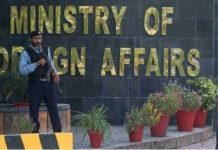Ahmad Jawad
Pakistan is one of the most important countries, population-wise, in Asia. It is considered the sixth most populous country in the world, with an estimated population of almost 220 million people. Most of the people reside in the four provinces of Khyber Pakhtunwala (KPK), Punjab, Sindh, and Baluchistan. It will be the fourth most populous country by the year 2050 in the world.
A famous Chinese saying is, “To understand today, one needs to know the history; and to know the future, one needs to review the past.”
BALUCHISTAN IS MOST IMPORTANT COMPONENT OF CPEC
Baluchistan is the most deprived province of Pakistan. It is located at the eastern edge of the Iran. It is geographically the largest of the four provinces with 347,190 sq km and equates to 42 percent of the total land area of Pakistan. The population density is very low due to the hilly territory and insufficiency of water and other human resources. It has 26 districts and the approximate population of Baluchistan is about 15 million.
Baluchistan is rich in natural resources. The economy is largely based on the production of natural gas, coal, and minerals. The province’s natural resources significantly help to meet the energy needs of Pakistan as a whole. Limited farming in the east and fishing along the Arabian Sea coastline are other forms of income and sustenance for the local population. Baluchistan is very poor in basic education.
It is expected that 2.0 million people are expected to move to Gwadar within a span of 30 years. The port is not yet functioning, but noticeable signs of progress have been seen. Similarly, new residential areas, hotels, buildings, schools, hospitals, and roads are indicative of modern trends. It also is expected to have a positive impact on the rest of the province, which has been neglected for a long time. Gwadar Port is a mega project of CPEC and a vast amount of investment is anticipated in both its infrastructure and extensions.
HISTORY OF CPEC:
The CPEC is an important agreement in improving regional connectivity as “strategic partners.” The idea became a reality in 2013 through the visit of Chinese Premier Li Keqiang to Pakistan. The historic memorandum of understanding between the two countries on CPEC was signed on July 5, 2013. In the same year, Prime Minister Nawaz Sharif visited China and signed eight agreements. Prime Minister Nawaz Sharif visited China again and 19 more agreements were signed in 2016.
The CPEC is an important part of One Belt One Road (OBOR).It is a package of infrastructure and energy projects, Its specific purpose is to upgrade and expand Pakistani infrastructure, linking China’s western province of Kashgar with Pakistan’s Gwadar Port on the Indian Ocean. Pakistan is a developing country; the CPEC is a great opportunity to enhance its economy. Through this mega project (CPEC), Pakistan’s population can reduce its poverty and achieve a higher standard of living.
In April 2015, Chinese president Xi Jinping visited Pakistan.During his visit, approximately 51 agreements were signed between China and Pakistan with a total worth of $46 billion, which also included the development of the CPEC. The original $46 billion that China invested in Pakistan under the CPEC has now expanded to approximately $54 billion. This amount exceeds all foreign direct investment. The result is that, over the last several years, Pakistan has received considerably more aid than it has received from the United States.
Benefits of CPEC:
1. Economic Boost:
The CPEC will show a major increase in Pakistan’s economy by increasing trade with China, Central Asia, Russia, Middle East and Europe. Even within the construction phase and completion of the CPEC there will be a visible economic growth in Pakistan by about 3 percent because of increase in industrial development due to the availability of resources.
2. Real Estate:
Between the construction phase of the CPEC and after the completion of CPEC route the value of the land surrounding is improving significantly and is providing many commercial opportunities to owners and developers of the land.
3. Agricultural Growth:
Due to increase in the agricultural production Pakistan will observe a significant agricultural growth with cooperation of China and sharing modern technology and strategies along with our feasible weather conditions.
4. Foreign Investment:
CPEC will promote foreign investment in Pakistan, which will ultimately show increase in our economic growth rate.
5. Great opportunities of Import and Export:
Another major advantage would be increase in the trade from which revenue will be generated, which will be earned from transiting goods to and from other countries.
6. Employment Opportunities:
CPEC would create employment opportunities for the local people to an extent of about two to three million which will contribute towards economic conditions of the Pakistan.
7. Tourism Development and Promotion:
The CPEC would provide for ideal tourism conditions in Pakistan, facilitating the flourishing of the tourism and hotel industry of Pakistan by providing a safe route and attractive commercial activity around Gawadar city.
8. Pakistan’s International role will be more prominent:
Many regional and extra-regional countries will be joining CPEC; this will improve Pakistan’s international stature, our contacts and will create an aura of peace and stability in the region.
9. Opportunity to develop and improve Relationship with other regional Countries:
South Asian countries will also prefer CPEC lead geo-economics over geopolitics and resolving major disputes like Jammu & Kashmir will get easier and peace will be achieved successfully. This would also facilitate South Asia’s interconnectivity and its connectivity with China, Central Asia, West Asia and Russia.
10. Defence Support:
CPEC will definitely bring vast strategic and economic advantages to Pakistan and regions surrounding it. Not only will CPEC will be beneficial for the country but the citizen of Pakistan will also be able to bear fruits of its development on individual level.
WAY FORWARD
PMLN Govt in alliance with PPP, is putting the CPEC on track with a high speed. Prime Minister Shahbaz Sharif and Minister of Planning and development Ahsan Iqbal are expected to take CPEC to new heights in the coming months.
Armed Forces of Pakistan are taking extra ordinary measures to provide security to CPEC projects and Chinese nationals working in Pakistan.
People of Pakistan are emotionally connected to CPEC and China. Public support in Pakistan will always be long term security of CPEC.
In future, OBOR will be a global connection and CPEC will be the founding stone of OBOR.

















